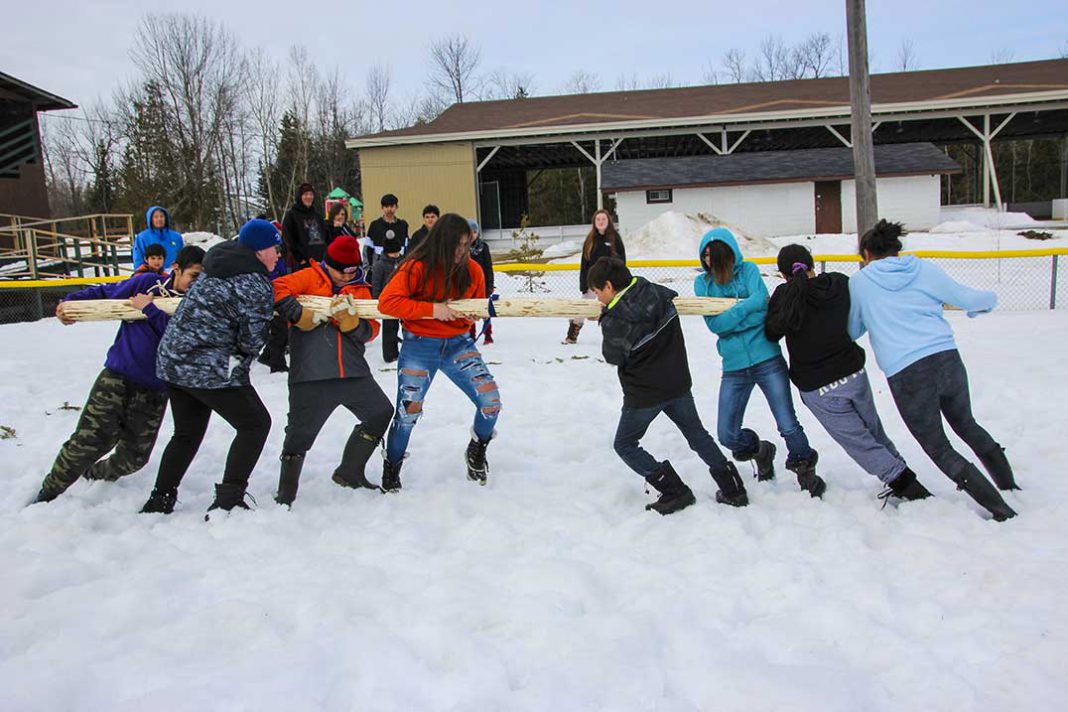AUNDECK OMNI KANING—Smiles, cheers and laughter were all that could be heard around the Four Directions Complex in Aundeck Omni Kaning on March 28 as schools from Manitoulin Island and the North Shore met to compete in Kenjgewin Teg’s second annual winter Indigenous Games.
“It was a great event,” said Steven Pruchnicki, co-facilitator of the event alongside Tonya Armstrong. “It was a little disorganized, but with 120 students and 10 educators, that’s to be expected.”
The seven schools that attended the event were Assiginack Public School (APS), Little Current Public School (LCPS), St. Joseph’s School (Sheshegwaning), Central Manitoulin Public School (CMPS), Lakeview School, Biidaaban Kinoomaagegamik (Sagamok), Manitoulin Secondary School and Kenjgewin Teg together as “Screamin’ Eagles,” a unified high school team, and Shawanosowe School.
Opening ceremonies began once all students had arrived at the complex. Mr. Pruchnicki called to the medicine wheel and the animal spirits of the deer, eagle, bear and wolf to offer agility, good sportsmanship, perseverance and resilience to the students respectively.
“I wish you good sportsmanship and a good day today,” Mr. Pruchnicki said before the students convened outside on the snowy ball diamond for a shinny competition.
Teams of five members played for 10 minutes using sticks to direct the tennis ball to a pylon at each end of the play area. The rules forbade slashing, contact, hands, goalies and high-sticking.
APS took first place in the primary division, LCPS took elementary and Sheshegwaning took the junior category.

Next up was snow snake, where teams of five aimed to throw their stick the farthest. Each player could decide their own throwing style. CMPS took the primary title, followed by APS for the elementary category and Lakeview School in the juniors.
Teams of four people plus one substitute took on the pole push, with opposing teams holding onto a pole and trying to push the other team outside of the circle—marked by cedar—in a best-two-of-three format.
APS took first place in the elementary division followed by Lakeview School in the junior category.
A five-member snowshoe relay race capped off the competitions. Each team raced back and forth across a set distance. If the snowshoes fell off in the primary division, they were allowed to carry them for the rest of the way. For the older groups, the shoes had to remain attached for the whole race.
Sagamok took the top spot in the primary and junior division, while Sheshegwaning took the elementary title.

With the events concluded, the students headed inside for the awards ceremony. Each student received a copper participation medal, a material chosen for its healing, cleansing and protective properties. Kimberley Debassige offered a teaching on the significance of copper in Anishinaabe traditions.
The first-place trophies were made of metal under the direction of Kenjgewin Teg welding student Dean Rising Sun Hare. The school’s dean of pathways Mark Gibeault made the wooden bases.
Before dismissing the students, Mr. Pruchnicki handed out a special award for the best team spirit.
“Based on injury count alone, there was one clear choice for this award,” said Mr. Pruchnicki with a laugh, before inviting Sagamok to accept the award. They jumped from their spot and ran up to the front, proving they were a worthy choice.

Team member Sierra Jacobs showed off her wrapped wrist and pointed to her friends sitting by her side who sported similar wraps.
“We all got injured in the pole push,” she said with a wide smile. “It was a lot of fun! Even though we got hurt, it was so fun.”
Sierra was an Indigenous Games veteran—she participated in last year’s event and said she also had a good time then. Her teammates agreed that this event made them feel proud of their Indigenous heritage.
Mr. Pruchnicki said the concept of hosting a major Indigenous Games event in this area was inspired by Kenjgewin Teg Executive Director Stephanie Roy.
“Physical education curriculum was lacking in Indigenous and culturally relevant content. Indigenous people feel more connected to these games and they have an element of nationhood,” said Mr. Pruchnicki.
All the games were played with objects that could be found in the natural environment, making them accessible to all people and increasing their connection to the land.
“It’s not often you hear that First Nations created something like this,” said Mr. Pruchnicki. “Their pride really goes up; there’s passion and dedication born out of the idea of these games.”
Other First Nations around Ontario have expressed interest in starting similar programs and Mr. Pruchnicki said he will be working with them to develop their own events.



